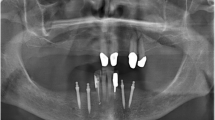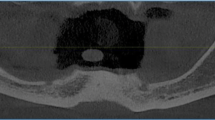Abstract
Objectives
The main objective of this study was to evaluate clinical and radiographic outcomes of implant-supported fixed partial prostheses, comparing platform switching and standard platform concepts.
Materials and methods
Patients with single or multiple partial edentulism were included in this prospective multicenter study. Success rate, as well as crestal bone loss and occurrence of complications were evaluated over time, for a minimum of 3 years after prosthesis delivery. Radiographic and clinical examination served to evaluate implant and prosthesis conditions.
Results
A total of 51 patients with 117 implants (55 in the centralized platform group and 62 in the standard platform group) were considered in the analysis. After 3 years of loading, the cumulative implant survival in test group was 90.3 %, while in the control group, it was 96.5 % without any statistically significant difference. After 3 years of function, the bone loss was 0.33 ± 0.19 mm in the test group and 0.48 ± 0.26 mm, revealing a significant difference.
Conclusions
Platform switching concept may lead to a reduction of marginal bone loss over time if compared to standardized one. Such effect seemed not to be related to a reduction of overall success rate of the treatment.
Clinical relevance
Platform switching could be a viable prosthetic option for implant treatment of partial edentulism.









Similar content being viewed by others
References
Albrektsson T, Zarb G, Worthington P, Erikson AR (1986) The long-term efficacy of currently used dental implants: a review and proposed criteria of success. Int J Oral Maxillofac Implants 1:11–25
Hermann JS, Cochran DL, Nummicoski PV, Buser D (1997) Crestal bone changes around titanium implants. A radiographic evaluation of unloaded nonsubmerged and submerged implants in the canine mandible. J Periodontol 68:1117–1130
Hermann J, Buser D, Schenk RK, Schoolfield JD, Cochran DL (2001) Biologic width around one-and two-piece titanium implants. A histometric evaluation of unloaded nonsubmerged and submerged implants in the canine mandible. Clin Oral Implants Res 12:559–571
Ericsson I, Persson LG, Berglundh T, Marinello CP, Lindhe J, Klinge B (1995) Different types of inflammatory reactions in peri-implant soft tissues. J Clin Periodontol 22:255–261
Abrahamsson I, Berglundh T, Lindhe J (1998) Soft tissue response to plaque formation at different implant systems. A comparative study in the dog. Clin Oral Implants Res 9:73–79
Berglundh T, Lindhe J (1996) Dimension of the periimplant mucosa. Biologic width revisited. J Clin Periodontol 23:971–973
Gardner DM (2005) Platform switching as a means to achieving implant esthetics. NY State Dent J 71:34–37
Baumgarten H, Cocchetto R, Testori T, Meltzer A, Porter S (2005) A new implant design for crestal bone preservation: initial observations and case report. Pract Proced Aesthet Dent 17:735–140
Lazzara RJ, Porter SS (2006) Platform switching: a new concept in implant dentistry for controlling postrestorativecrestal bone levels. Int J Periodontics Restorative Dent 26:9–17
Calvo Guirado JL, Saez Yuguero MR, Pardo Zamora G, Muñoz Barrio E (2007) Immediate provisionalization on a new implant design for esthetic restoration and preserving crestal bone. Implant Dent 16:155–164
Hermann F, Lerner H, Palti A (2007) Factors influencing the preservation of the periimplant marginal bone. Implant Dent 16:165–175
Maeda Y, Miura J, Taki I, Sogo M (2007) Biomechanical analysis on platform switching: is there any biomechanical rationale? Clin Oral Implants Res 18:581–584
(2000) World Medical Association Declaration of Helsinki: ethical principles for medical research involving human subjects. JAMA 284:3043-3045
Jemt T (1997) Regeneration of gingival papillae after single-implant treatment. Int J Periodontics Restorative Dent 17:327–333
Atieh MA, Ibrahim HM, Atieh AH (2010) Platform switching for marginal bone preservation around dental implants: a systematic review and meta-analysis. J Periodontol 81:1350–1366
Al-Nsour MM, Chan HL (2012) Wang HL (2012) Effect of the platform-switching technique on preservation of peri-implant marginal bone: a systematic review. Int J Oral Maxillofac Implants 27:138–145
Prosper L, Redaelli S, Pasi M, Zarone F, Radaelli G, Gherlone EF (2009) A randomized prospective multicenter trial evaluating the platform-switching technique for the prevention of postrestorative crestal bone loss. IntJ Oral Maxillofac Implants 24:299–308
Herekar M, Sethi M, Mulani S, Fernandes A, Kulkarni H (2014) Influence of platform switching on periimplant bone loss: a systematic review and meta-analysis. Implant Dent 2014 May 9
Makigusa K, Toda I, Yasuda K, Ehara D, Suwa F (2014) Effects of platform switching on crestal bone around implants: a histomorphometric study in monkeys. Int J Periodontics Restorative Dent 34(Suppl):s35–s41
Guerra F, Wagner W, Wiltfang J, Rocha S, Moergel M, Behrens E, Nicolau P (2014) Platform switch versus platform match in the posterior mandible—1-year results of a multicentre randomized clinical trial. J ClinPeriodontol 41:521–529
Wang YC, Kan JY, Rungcharassaeng K, Roe P (2014) Lozada JL (2014) Marginal bone response of implants with platform switching and non-platform switching abutments in posterior healed sites: a 1-year prospective study. Clin Oral Implants Res. doi:10.1111/clr.12312
Telleman G, Raghoebar GM, Vissink A, Meijer HJ (2014) Impact of platform switching on peri-implant bone remodelling around short implants in the posterior region, 1-year results from a split-mouth clinical trial. Clin Implant Dent Relat Res 16:70–80
De Angelis N, Nevins ML, Camelo MC, Ono Y, Campailla M, Benedicenti S (2014) Platform switching versus conventional technique: a randomized controlled clinical trial. Int J Periodontics Restorative Dent 34(Suppl):s75–s79
Broggini N, McManus LM, Hermann JS, Medina R, Schenk RK, Buser D, Cochran DL (2006) Peri-implant inflammation defined by the implant-abutment interface. J Dent Res 85:473–478
Canullo L, Pellegrini G, Allievi C, Trombelli L, Annibali S, Dellavia C (2011) Soft tissues around long-term platform switching implant restorations: a histologic human evaluation Preliminary results. J ClinPeriodontol 38:86–94
Becker J, Ferrari D, Herten M, Kirsch A, Schaer A, Schwarz F (2007) Influence of platform switching on crestal bone changes at non-submerged titanium implants: a histomorphometrical study on dogs. J ClinPeriodontol 34:1089–1096
Degidi M, Iezzi G, Scarano A, Piattelli A (2008) Immediately loaded titanium implant with a tissue-stabilizing/maintaining design (‘beyond platform switch’) retrieved from man after 4 weeks: a histological and histomorphometrical evaluation A case report. Clin Oral Implants Res 19:276–282
Liu S, Tang C, Yu J, Dai W, Bao Y, Hu D (2014) The effect of platform switching on stress distribution in implants and periimplant bone studied by nonlinear finite element analysis. J Prosthet Dent. doi:10.1016/j.prosdent.2014.04.017
Pessoa RS, Bezerra FJ, Sousa RM, Sloten JV, Casat MZ, Jeacques SV (2014) Biomechanical evaluation of platform-switching: different mismatch sizes, connection types and implant protocols. J Periodontol 2014 May 7
Martini AP, Barros RM, Junior AC, Rocha EP, de Almeida EO, Ferraz CC, Pellegrin MC, Anchieta RB (2013) Influence of platform and abutment angulation on peri-implant bone A three-dimensional finite element stress analysis. J Oral Implantol 39:663–669
Khurana P, Sharma A, Sodhi KK (2013) Influence of fine threads and platform-switching on crestal bone stress around implant-a three-dimensional finite element analysis. J Oral Implantol 39:697–703
Xia H, Wang M, Ma L, Zhou Y, Li Z, Wang Y (2013) The effect of platform switching on stress in peri-implant bone in a condition of marginal bone resorption: a three-dimensional finite element analysis. IntJ Oral Maxillofac Implants 28:e122–e127
Tabata LF, Rocha EP, Barao VA, Assuncao WG (2011) Platform switching: biomechanical evaluation using three-dimensional finite element analysis. IntJ Oral Maxillofac Implants 26:482–491
Canullo L, Pace F, Coelho P, Sciubba E, Vozza I (2011) The influence of platform switching on the biomechanical aspects of the implant-abutment system. A three dimensional finite element study. Med Oral Patol Oral Cir Bucal 16:e852–e856
Acknowledgments
Dental Tech S.R.L. (Misinto, Milano, Italy) generously provided all the implants and material needed for this study.
Conflict of interest
Authors declare they are free from any conflict of interest. The company providing the implants (Dental Tech S.R.L.) did not interfere at all with designing and carrying out of the study, and none of the authors received any compensation for their contribution to this study.
Author information
Authors and Affiliations
Corresponding author
Rights and permissions
About this article
Cite this article
Del Fabbro, M., Bianchessi, C., Del Lupo, R. et al. Platform switching vs standard implants in partially edentulous patients using the Dental Tech Implant System: clinical and radiological results from a prospective multicenter study. Clin Oral Invest 19, 2233–2244 (2015). https://doi.org/10.1007/s00784-015-1462-z
Received:
Accepted:
Published:
Issue Date:
DOI: https://doi.org/10.1007/s00784-015-1462-z




